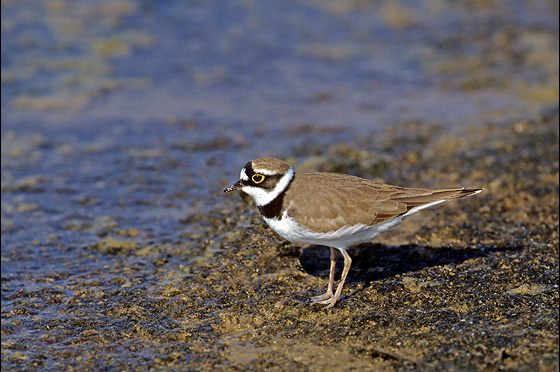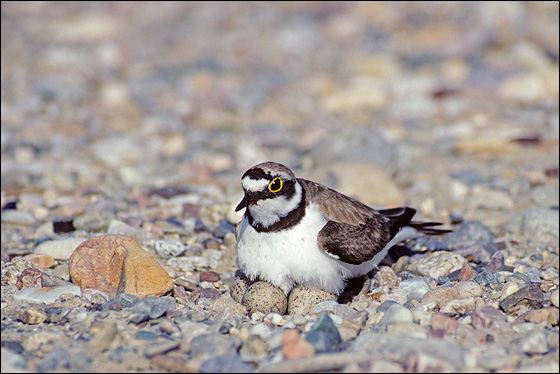Little Ringed Plover (Charadrius dubius)
Three very clear behavioural features separate the Little Ringed Plover from its close relatives the Ringed and Kentish Plovers: it shuns sea coasts when breeding; it is not very sociable, being found only in small flocks of a dozen at the most; and it is exclusively a summer visitor to Europe, arriving as early as March and departing before the end of September to its wintering grounds in sub-Saharan Africa. Plumage-wise, though, it is very similar to the Ringed Plover, and the chicks have such similar patterning that, where both species forage with their chicks in the same places after hatching, broods can become hopelessly mixed up and individual chicks inadvertently swapped around.
These small plovers are highly aggressive on the breeding grounds, and even have a special Hostility-Flight display directed at rivals. More often, though, advertising males simply fly at low altitude over the territory and beyond, describing wide circles or figures of eight, with exaggerated slow wing-beats and occasional tilts from side to side. Yet despite their obvious hot-headedness, some pairs allow a third bird to live within the territory. It may help in territorial defence and even take a turn in incubating the eggs.
The natural breeding habitat of the Little Ringed Plover comprises the edges and banks of freshwater lakes and rivers, plus brackish flats and lagoons. In recent years, however, the bird has also spread to artificial sites, such as gravel pits and sewage farms. As a species it is used to rapidly changing conditions and setbacks – it will replace a lost clutch up to three times, for example – so it has managed to thrive in these unlikely places. Young from first broods may leave their natal area from late June onwards and wander locally, perhaps uncovering potential sites for future colonisation.
These small plovers are highly aggressive on the breeding grounds, and even have a special Hostility-Flight display directed at rivals. More often, though, advertising males simply fly at low altitude over the territory and beyond, describing wide circles or figures of eight, with exaggerated slow wing-beats and occasional tilts from side to side. Yet despite their obvious hot-headedness, some pairs allow a third bird to live within the territory. It may help in territorial defence and even take a turn in incubating the eggs.


